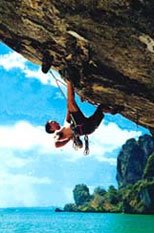On the good-sized island Koh Samui in the gulf of thailand, the taxi and sawngthaew (pickup truck with seats in the back) drivers form what can only be described as a mafia. They charge exorbitant rates to all tourists, who want to visit the next beach or go out to a restaurant at night. This frustrating situation has the unfortunate side-effect of encouraging many foreigners who have zero experience riding motorcycles to rent them, with predictably bad consequences, but that's another story.
We had chosen to splurge on a nice dinner in the next town away, and paid the high price to ride on a bench in the back of a smoky pickup. Sometimes it feels difficult to find a chef in asia who will creatively step outside tradition, but we did really well that night at 'betelnut' in chaweng beach. After a nice meal, we decided to hell with the taxis, we'd walk back to our hotel and let our full tummies percolate. It turned out to be an amazingly longer walk than we thought, nearly two hours! But that's not the exciting part...
We had been walking close to an hour in a half in semi-populated areas, intermittently well lit by streetlights and getting fairly dark, though not nearly as dark as Myanmar streets with the power out. We were not too far from our hotel, around 1am. A car or motorbike would whizz by once in a while. Abruptly, A motorbike with two young thai men stopped just next to us on the side of the road. One said, "Lamai?" which was the name of the beach we were heading toward. I said, "Lamai, yes, just walking," and ignored the men, hardly looking at them and walking right by, assuming they had some sort of sales pitch. Tiffany watched them more carefully but moved ahead.
After we had walked a few paces, we heard the engine roar and the motorbike came right toward us facing into the shoulder, the front wheel coming right between us. The guy on the back of the bike hopped off, saying "I want your bag!"
~> read more
to both of us, but it was Tiffany who had a purse over her shoulder. We both screamed "No!" directly into the guy's face. Somehow, though we were tense and afraid, it didn't feel like a mugging, it just felt like any of so many other scams we had encountered along the way. The motorcycle had split Tiffany and I apart, but I just started walking toward the assailant agressively. Then, he pulled out a knife, not a crocodile dundee knife but a large box-cutting knife as was used in the 9/11 highjackings. Scarier in the moment than on the shelf in the hardare store, to be sure. I kept my distance, he started to run toward me and I ran backwards, watching him, but I kept his attention, he did not turn away. Tiffany, by this time, had made her way to the opposite side of the 2-lane road as the two men were distracted by my behavior.
We then had a grand stroke of luck. Nearly at the same time, a car taxi and motorcycle approached at cruising speed from each direction. Tiffany jumped out and stood in the middle of the lane, waving her hands in an X, SOS style in a clear sign of distress in front of the taxi. But... the taxi just honked! Tiffany practically had to dive into the ditch to keep from being hit. She then ran toward the other lane to wave down the approaching motorcycle driver, who stopped immediately for us. In all this commotion, the would-be muggers decided things had gone awry and hopped back on their bike and took off. The motorycle driver who had stopped was northern european and had his female partner on the back. They really didn't understand our frantic English, and stared at us with wide eyes. In any case we had no intention to start a high-speed chase and were glad our assailants had departed, so we thanked the europeans and sent them off.
Upon reflection, we feel that the most remarkable part of this whole scenario was our reaction to the muggers. After so many challenges to tough it out through, we reacted without fear, but with pure anger! This may signal that it is time to go home, but it was also empowering because we felt we won in a way. Our actions might not have been the smart choice, but we were fortunate to come out ahead. If you see one of us walking down the street, don't feel bad if we ignore you. We have had many challenges, from simple street hawkers trying to sell you a souveneir, to police pulling you over for a bribe (in more than one country). This incident, more than any other, taught us that we had become tough travellers, for better or for worse.
In broad daylight the next day, we witnessed a woman crying just after a motorbike had whizzed by, the passenger had cut her purse straps, and stolen the purse. From this, we pieced together that the not-as-intimidating-as-it-could-be knife was normally used for just cutting purse straps in a surprise attack. Tiffany had been very carefult to keep her bag on her side between us, not her side next to the road. We think that our muggers couldn't slash the strap the way they wanted, so they tried another method way out in the dark. But they weren't dealing with your average 2 week vacationers on Samui!!

